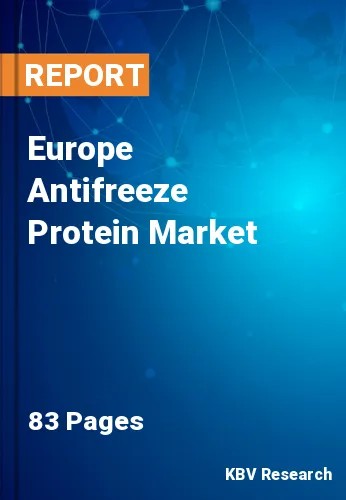The Europe Antifreeze Protein Market would witness market growth of 25.2% CAGR during the forecast period (2022-2028).
A nanolitre osmometer can quickly detect thermal hysteresis in the lab. The values of thermal hysteresis vary amongst organisms. Fish AFP has a maximum thermal hysteresis of about 3.5 degrees Celsius. Aquatic species, on the other hand, are only exposed to temperatures of 1 to 2 degrees Celsius below freezing. During the coldest months of the year, the spruce bud-worm may survive temperatures as low as -30°C. Upis ceramboides, an Alaskan beetle, can survive at -60°C by employing antifreeze molecules that aren't proteins.
The thermal hysteresis value of AFPs can be influenced by the pace of cooling. Rapid cooling can lower the non - equilibrium freezing point and thus the thermal hysteresis value significantly. As a result, if the temperature decreases suddenly, organisms may not be able to adjust to the sub-zero environment.
The increasing incidences of infertility rate among the regional population are opening up chances for the medical technology industry, which is nearly completely made up of small and medium-sized businesses in Germany. The local market's upbeat outlook, along with strong exports of Medtech Made in Germany, resulted in a 10.4 percent increase in domestic industry turnover. One of the most fascinating areas of health care is making it easier for people to recuperate from surgical procedures. International businesses in the sector are discovering that Germany, Europe's largest health market, is an excellent place to establish a presence and expand sales. With a 9.9% share of medical technology production, Germany is the world's third-largest manufacturing nation.
The close partnership between research and industry has helped Germany's medical technology sector become a benchmark for quality, performance, and safety. Expenditures for medical aid have been steadily increasing over the past decade, rising by 3.7 percent per year to a new high of EUR 20.6 billion in 2019. Health insurance companies refund a significant amount of expenses. Hence, due to growing opportunities for medical technology companies, the antifreeze protein market is likely to propel in the forecast period.
The Germany market dominated the Europe Antifreeze Protein Market by Country 2021, and would continue to be a dominant market till 2028; thereby, achieving a market value of $1,937 Thousands by 2028. The UK market is poised to grow at a CAGR of 24.2% during (2022 - 2028). Additionally, The France market would display a CAGR of 26.1% during (2022 - 2028).
Based on Type, the market is segmented into Type I, Type III, Antifreeze Glycoprotein, and Others. Based on Form, the market is segmented into Solid and Liquid. Based on Source, the market is segmented into Fish and Others. Based on End-use, the market is segmented into Medical, Food, Cosmetics, and Others. Based on countries, the market is segmented into Germany, UK, France, Russia, Spain, Italy, and Rest of Europe.
Free Valuable Insights: The Global Antifreeze Protein Market will Hit $29 Million by 2028, at a CAGR of 25.7%
The market research report covers the analysis of key stake holders of the market. Key companies profiled in the report include Kaneka Corporation, Unilever PLC, Nichirei Corporation, A/F Protein Canada Inc., Sirona Biochem, Protokinetix, Inc., Shanghai Yu Tao Industrial Co., Ltd., Kodera herb garden co., ltd., Rishon Biochem Co., Ltd., and Mybiosource, Inc.
By Type
By Form
By Source
By End Use
By Country
Our team of dedicated experts can provide you with attractive expansion opportunities for your business.

